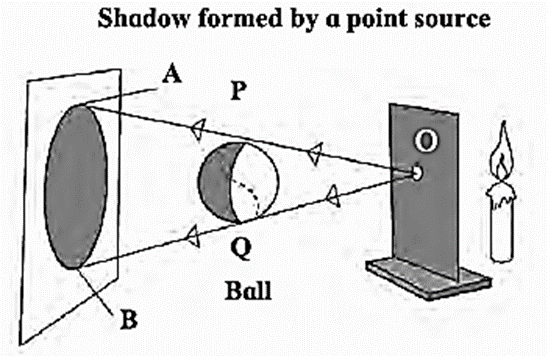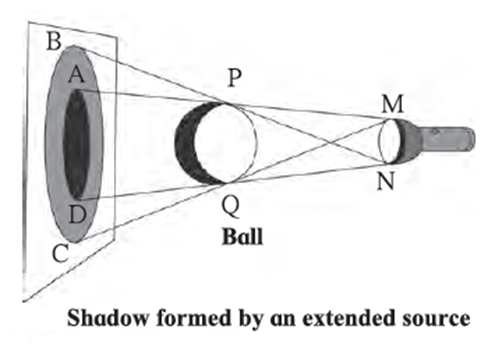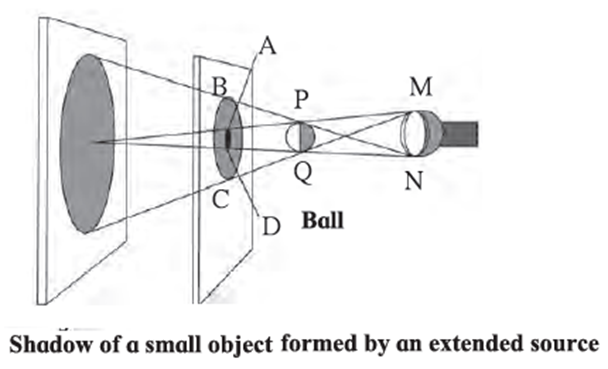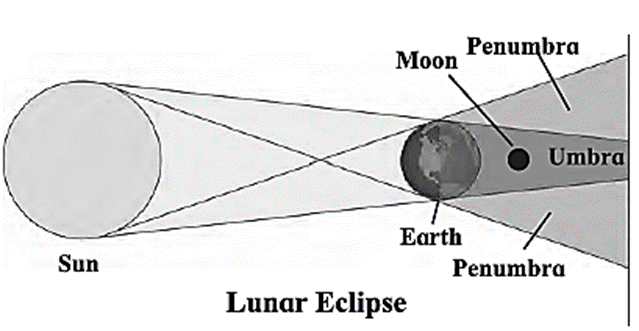Effects of Light
Maharashtra Board-Class 7th-General Science-Chapter-17
Notes
Topics to be Learn:
|
Scattering of light : A ray of light is composed of several colours. Scattering of light means to separate constituents of light or to spread light. Sunrays after passing through the prism show bands of seven colours, violet, indigo blue, grey, yellow, orange and red.
Phenomena related to Scattering of light : Beam of light, Blue sky, Reflection, Dispersion, Refraction Reddish appearance of sun
Shadow formed by a point source and an extended source
Shadow : The light emerging from a source of light illuminates the screen placed in front of it, But, if an object is placed between the source of light and the screen, the light rays get obstructed by the object. As that part of the screen does not get illuminated, it remains dark. This dark part is known as shadow.
Phenomena related to Shadow
- Point Source : Umbra
- Extended Source : Umbra, Penumbra
Shadow formed by a point source and an extended source
Shadow : The light emerging from a source of light illuminates the screen placed in front of it, But, if an object is placed between the source of light and the screen, the light rays get obstructed by the object. As that part of the screen does not get illuminated, it remains dark. This dark part is known as shadow.
Phenomena related to Shadow
- Point Source : Umbra
- Extended Source : Umbra, Penumbra
Point source : When a source of light is very small in size (e.g., light emerging from a hole), it is called a point source. When an object is placed in the path of light emerging from a point source, only one shadow is formed on the screen. The shadow formed is dark and is known as the umbra.

Extended source : When a source of light is bigger in size (e.g., light emerging from a torch), it is called an extended source. When an object is placed in the path of light emerging from an extended source, the shadow is seen with two parts. The darker part of shadow is known as the umbra and the fainter/lighter part of shadow is known as the penumbra. (i) When the screen is moved away from the object which is bigger than the extended source of light, the size of both the shadows (umbra and penumbra) goes on increasing. (ii) On the other hand, when the screen is moved away from the object which is smaller than the extended source of light, the size of umbra goes on decreasing and after a certain distance it disappears.


Eclipses : When the sun, the moon, the earth all revolving in different orbits come in a straight line, an eclipse occurs. This is a natural phenomenon.
Solar eclipse : The sun is an extended source of light which is extremely big in size. When the moon comes between the sun and the earth, the sunlight is obstructed by the moon. Thus, the shadow of the moon falls on the earth. The sun can be seen partially or cannot be seen completely from the part in the shadow. This phenomenon is called a solar eclipse.

- The harmful ultra-violet rays emerging from the sun reach the earth, even during a solar eclipse. Thus, the solar eclipse should never be seen/watched with the naked eye, instead special type of goggles should be used to see/ watch it.
- A solar eclipse takes place only on a new moon day. It should be noted that the solar eclipse does not occur on all new moon days.
Types of Solar Eclipses :
Lunar Eclipse : When the earth comes between the sun and the moon in the space the earth obstructs the sunlight. Thus, the shadow of the earth falls on the moon. This phenomena is called lunar eclipse.

|
Remember : Many superstitions connected to eclipses are prevalent in the society. It is necessary that everyone makes efforts to rid the society of superstitious beliefs. We will make people understand and accept the fact that an eclipse is a natural phenomenon like rain, spectrum, seasons. |
Q. The moon comes between the sun and the earth twice in a year. But why solar eclipse does not take place at each of this times?
Ans. A source of light, an object and a screen should be in a straight line, to get a shadow of the object. In a same way; the sun, the moon and the earth should come in a straight line to fall the shadow of the moon on the earth. Many times, the moon comes between the sun and the earth. But, all these celestial bodies do not lie/ come in a straight line. At such times, the shadow of moon does not fall cast on the earth and hence a solar eclipse does not take place.
Occultation : When a planet or a star gets covered behind the moon, the phenomenon is called a occultation.
- In November 2016, the star called ‘Rohini’ was hidden behind the moon and the phenomenon of occultation took place.
Zero shadow day :
- On this day, the sun reaches exactly over our head.
- This phenomenon occurs at noon. At this time, our shadow appears to be vanished completely. Or, This phenomenon occurs at noon. At this time, our shadow disappears completely.
- At the time of this event, a shadow of a person standing erect (without stretching his/her hands and legs) falls right below the base of his/her feet. This shadow is not seen, due to which it appears to be vanished. But, if the person stretches hisher hands out, its shadow is seen.
- This event occurs in the region between the Tropic of Cancer (23.5 °N) and the Tropic of Capricorn (23.5 °S).
| Main Page : Class 7th MSBSHSE – General Science - All chapters notes, solutions, videos, test, pdf.
Previous Chapter : Chapter 16 : Natural Resources - Online Notes Next Chapter : Chapter-18- Sound : Production of Sound-Online Notes |